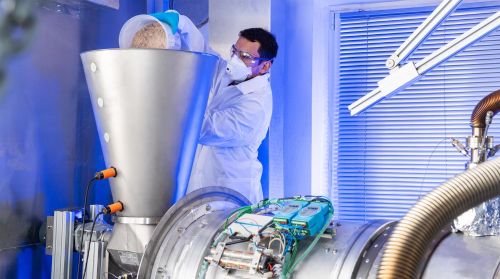ifm sensors at DLR (German Aerospace Centre)
Sustainable cement production: can solar energy replace fossil fuels? A simulation of the first production step was successful - monitored by ifm sensors.

For the cement production process solar researchers of the German Aerospace Centre (DLR) analysed how solar energy can replace fossil fuels. Using the solar simulator at the DLR Institute of Solar Research in Cologne the first production step, i.e. the heating and calcination of the raw cement powder, was successfully tested in a rotary kiln.
Also involved: ifm sensors! The KI5 type sensors monitor a typical critical area from the "empty" to the "too empty" condition.
The upper ifm sensor signals that half of the material has been processed. The lower ifm sensor would switch off if it detected no material any more. This helps to prepare the end of the experiment in order to prevent overheating and damage to the reactor.
The goal of the campaign was to demonstrate the reliable multi-hour operation of the reactor spread over several days. The raw material was heated at different flow rates in the rotary kiln to a temperature of 1000 degrees Celsius and calcinated. The scientists managed to produce heated raw cement powder of the same quality as is possible with conventional reactors.
Did you know? Cement is one of the most frequently used commodities worldwide and the most important construction material of our time. Its production requires high temperatures which are mainly generated by burning fossil fuels. So a sustainable process would make an important contribution to the reduction of global emissions. |